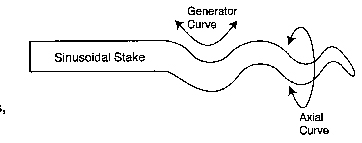BEGINNING ANTICLASTIC RAISING
Playing with Hammers
with Jerry Scavezze
“An introduction to Anticlastic Raising” will be taught by jeweler and metalsmith, Jerry Scavezze. This class will teach the basics of anticlastic raising, construction of a spiculum and how to bend it, the concept of trading one curve for another, how to hammer in a twist, and a graphic demonstration of how and where the metal is stretched, and many other concepts. Jerry was selected as one of 12 new designers of the year in 1993 and sells his anticlastic jewelry through galleries and shows nationwide. His work has been featured regularly in many national magazines. Students should have a basic knowledge of metalworking techniques. Vises, some hammers, and sinusoidal stakes will be supplied. If you have favorites including sinusoidal stakes either in steel or plastic of your own, please feel free to bring them. Please bring Hand tools (pliers, files, and any other personal favorites) Each student will take home a finished pair of sterling earrings.
Instructor Jerry Scavezze
Class is 3 days and the fee is $400.00
Materials fee will apply.
Tools will be available for purchase.
Anticlastic Raising
By jerry Scavezze
copyright 1999
Synclastic Form (Bowl Shape)
Synclastic forming
A technique used to form sheet metal into vessels, etc. The metal is stretched in the center and compressed on the edges. Both major curves at 90 degrees to each other will go in the same direction. The ultimate form will be a bowl or dome shape.
Anticlastic Form (Saddle Shape)
Anticlastic forming
This technique is used to form compound curves in sheet metal. Using this process the metal is compressed in the center and stretched on the edges. The major curves in the form will go in opposite directions. The resulting form is that of a saddle or “Pringle” potato chip.
Generator Curve  Sinusoidal Stake
Sinusoidal Stake
Misc… thoughts, tips, etc.
Anneal early and often.
Anticlastic raising is almost always done using a combination of steel and plastic or wooden tools. A plastic mallet and a steel stake is quickest but leaves a lot of planishing to be done and offers less control. A steel hammer and a plastic (delrin) stake is generally the preferred method. This combination offers reasonable speed, good control and a fairly well planished final form.
One of the most important concepts to remember in anticlastic raising is that the generator and axial curve relate to each other directly. If you tighten the generator curve the axial curve will open and conversely, if you tighten the axial curve the generator curve will open.
Throw the hammer at the metal. Hold the hammer or mallet very loosely at the point of impact or you will pay for the mistake with your body (elbow and other joint pain). This work can be very hard on your body. Take care of it! I’m not kidding on this point!
Recommended Reading and further explorations
Form Emphasis for Metalsmiths, Heikki Seppa, Kent State Univ. Press, 1978 Metals Technic, Brynmorgen Press, 1992
Jerry Scavezze
jerryscavezze
Latest posts by jerryscavezze (see all)
- David Huang workshop beginning Monday June 7 - May 29, 2010
- 2010 Class Schedule - February 5, 2010
- Anticlastic Raising like you’ve never seen it! - March 3, 2009




{ 2 comments… read them below or add one }
I would like to know where I can get sinusoidal stake(s). I live in Aberdeenshire in Scotland and am not able to locatethis tool in the U.K. Any ideas as to how I might aquire this tool. I have been doing jewelry classes over the past four years. I do it as a hobby and not a bussines and I am interested in developing new skills. I just love doing pieces that involve hammering.
Look forward to hearing from you.
Regards
Blanche
I am intereted in learning anticlastic and synclastic forming. I did not see a scheduled date for this fall. Is anything scheduled? Thanks.